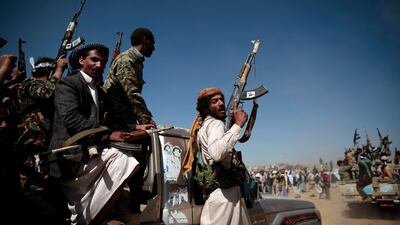The grainy, seemingly innocuous photograph of four solemn men sitting on sofas has far graver implications than it implies. The picture, disseminated by Hezbollah’s media office over the weekend, shows its Iran-sponsored leader Hassan Nasrallah sitting alongside a delegation of high-ranking Houthi militia, whose violent campaign in Yemen has perpetuated a three-year war. It confirmed what many in this region already know: that via its proxies, the Iranian regime is joining the dots in its bid to build a land bridge from Tehran to Beirut and destabilise the region in the process.

It is deeply concerning that the two groups are aligning interests, ahead of UN talks that aim to bring peace and prosperity to Yemen, not further chaos. The Houthi rebels, who have repeatedly tried to assert their right to control parts of Hodeidah and are embedded in Sanaa, are determined to stake a permanent foothold and power base. But as UAE Minister of State for Foreign Affairs Anwar Gargash tweeted in response to the photo of Houthi leaders cosying up to Hezbollah: “Lebanon cannot be a logistical or political station for Houthis”. For with each new alliance which the Iranian regime uses to spread its poisonous roots, the region teeters closer to instability.
The timing of the Lebanon meeting is significant given the approach of peace talks in Geneva between the Houthis and Yemen's rightful government on September 6. The Iranians want a seat at the table but have no right to occupy one. It is clear that the Houthis are posturing and flaunting their ties to Hezbollah and Iran in a bid to negotiate from a position of apparent strength. It also seems that the Houthis are seeking to replicate what Hezbollah has achieved in Lebanon – to carve out a state within the state and fulfil Tehran's military ambitions under the guise of governance. The flaws of such a system are evident in Lebanon's fractured. Meanwhile the Houthis have shown themselves utterly incapable of governing in Yemen, where they have relied on violence and tyranny. Hezbollah's preposterous claim that the Houthis are battling "imperialism" are nonsense when it is the rebels who have supplanted Abdrabu Mansur Hadi's legitimate government.
Indeed, the image released by Hezbollah makes a mockery of its previous denial of co-operation with the Houthis. In June, the Saudi-led coalition reported it had killed eight Hezbollah fighters alongside Houthi militia in Yemen. Meanwhile Hezbollah has been accused of providing training, support and ballistic missiles, supplied by Iran, to the Houthis. At this watershed moment, as the date of talks approaches, this unholy alliance is an omen of mal-intent. Attempts by the Houthis to establish a presence in Lebanon or to replicate the Hezbollah model within Yemen will threaten the region’s security still further and destroy hopes for peace for Yemenis, who must be served better.

